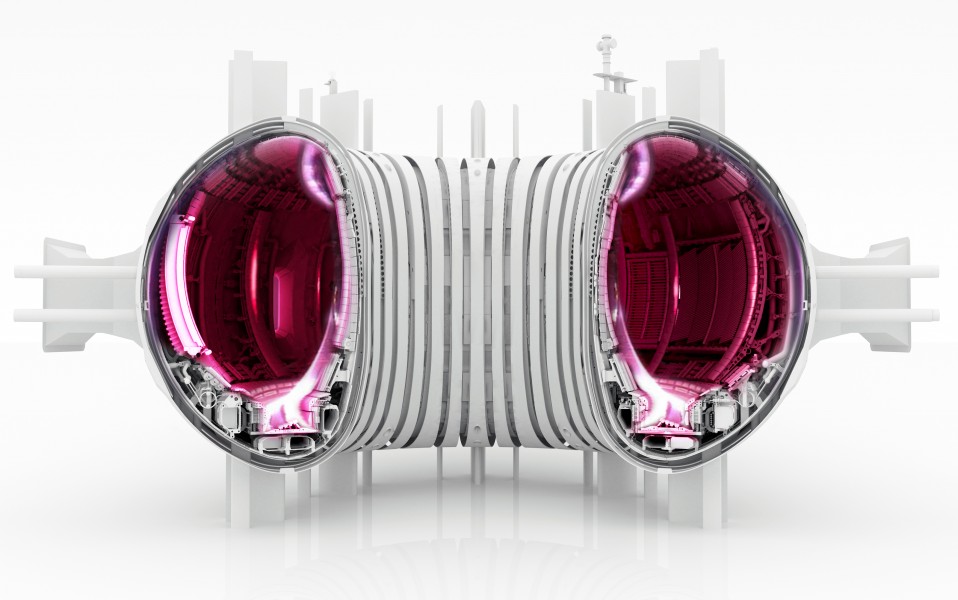A future fusion power plant could harness boundless energy from the reaction that powers the sun itself: nuclear fusion. During this process hydrogen nuclei fuse together under extreme temperatures of 150 millions of degrees, to yield energy in the form of heat.
To achieve fusion, researchers have been practicing holding hot bubbles of gas or plasma in donut-shaped reaction chambers called tokamaks, where strong magnetic fields and electric currents keep the plasma in check. One example is the research device JET, the six-meter-sized Joint European Torus in Culham, UK.
Ingredient T
So far, most of the practice that fusion researchers gotten has made use of the atoms hydrogen (H, one proton) and deuterium (D, with an added neutron). These offer practical ways of testing heating, confinement and control systems, but they lack one key element – they hardly produce any fusion reactions. Future fusion reactors will instead run on a mixture of the two hydrogen isotopes deuterium and tritium, which offers by far the easiest conditions for practical fusion.
The fact that the ideal fusion fuel mix includes tritium (T) is a challenge, because the this isotope of hydrogen (one proton and two neutrons) is rare, radioactive and unstable, decaying with a 12.3 year half life. No wonder that JET is the only fusion facility in the world capable of operating on a mix of D-T.
To prepare for its new experimental campaign using D-T, dedicated experiments were set up to gain experience with operatingin pure tritium. This gives a rare insight in how this rare isotopes influences all kinds of processes in the fusion plasma, says Joëlle Mailloux, a nuclear physicist at the UKAEA and one of the task force leaders of these campaigns.
‘A very exciting time for us’
‘We did this T-T campaign for two reasons’, says Mailloux, ‘one, to prepare for the D-T-campaign, and two, to understand the physics of tritium in the reactor better. So after preparing for years, this was a very exciting time for us.’
One of the main research areas of a fusion physicist is core confinement: how well can you make magnets hold a plasma with temperatures of 150 million degrees Celsius. And once you can do it with hydrogen, how do you translate this skill to tritium, which is three times heavier than hydrogen? ‘This is what we want to find out in the first place’, says Mailloux.
Difficult to disentangle
However, with a plasma of D and T, there is another effect to keep track of: a fusion reaction that produces alpha particles, or helium nuclei, which predictions show should have an effect on magnetic confinement due to electromagnetic effects. So even while the whole point is fusing D and T, says Mailloux, ‘in experiments, it’s difficult to disentangle which effect is which.’ Pure tritium, which can fuse a bit with itself but doesn’t produce alpha particles, lets you do just that.
Testing the new tokamak wall
Keeping hot plasma confined with magnetic fields isn’t the only challenge in fusion. Some of the plasma will inevitably hit the inner walls of the device, so it is important to understand how the wall holds up under that incandescent touch.
The last time D-T experiments were done, in 1997, JET had an inner wall out of solid carbon. The future fusion ITER, however, will get a wall made of the materials beryllium and tungsten, which does not erode as much under interaction of the plasma with the wall. In order to gain experience with these new materials, JET has also been fitted with such an ITER Like Wall.
Under the onslaught of the plasma, it’s inevitable that some wall material ends up in the plasma, while tritium particles get lodged into the wall. Since tritium is radioactive and quite expensive, this has to be won back afterwards, and meticulously accounted for.
In general, says Mailloux, the radioactive nature of tritium makes experiments more cumbersome. ‘Something that would normally have taken half an hour to fix, might take two and half hours now.’
No big physics surprises, luckily
But the trouble was worth it, she insists. ‘We had some unexpected results and adapted procedures and experiments, but no big physics surprises, which is very encouraging.’ And although a full analysis of the results will take months to years to complete, the first lessons of the TT-campaign are already incorporated in the DT2-campaign that just concluded.




